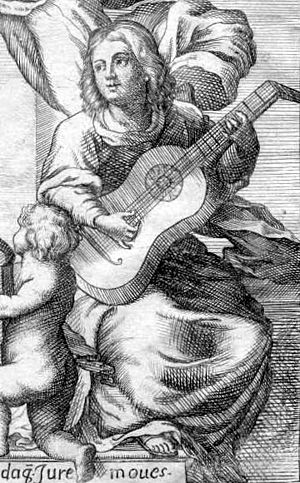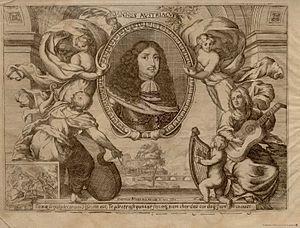Gaspar Sanz facts for kids
Francisco Bartolomé Sanz Celma (baptized April 4, 1640 – 1710), known as Gaspar Sanz, was a Spanish composer, guitarist, and priest. He was born into a wealthy family in Calanda, Spain.
Sanz studied music, theology, and philosophy at the University of Salamanca. He later became a Professor of Music there. He wrote three important books for the baroque guitar. These books are still used today in classical guitar lessons. They also help experts understand how baroque guitar was played.
Contents
Life Story of Gaspar Sanz
Gaspar Sanz was baptized as Francisco Bartolomé Sanz Celma on April 4, 1640. This happened in the church of Calanda de Ebro, Aragon. He later started using the first name "Gaspar."
After finishing his studies at the University of Salamanca, Gaspar Sanz traveled. He went to Naples, Rome, and possibly Venice. He wanted to learn more about music. He may have studied with Orazio Benevoli, a choirmaster at the Vatican. He might also have learned from Cristofaro Caresana, an organist in Naples.
Sanz learned to play the guitar from Lelio Colista. He was also inspired by other Italian guitarists. These included Foscarini, Granata, and Corbetta. When Sanz returned to Spain, he became a guitar teacher. His student was Don Juan (John of Austria). Don Juan was the son of King Philip IV.
In 1674, Sanz wrote his famous book, Instrucción de Música sobre la Guitarra Española. It was published in Saragossa and dedicated to Don Juan. A second book, Libro Segundo de cifras sobre la guitarra española, came out in 1675. A third book, Libro tercero de mùsica de cifras sobre la guitarra española, was added later.
All three books were published together in 1697. They were printed eight times in total. These books contain ninety musical pieces. They are his only known works for the guitar. They include pieces played by plucking strings (punteado) and by strumming (rasqueado).
Besides music, Gaspar Sanz was also known as a poet and writer. He wrote some poems and two books. These literary works are mostly forgotten today. He also translated a famous book called L'huomo di lettere by Jesuit Daniello Bartoli. His translation first appeared in 1678.
Gaspar Sanz passed away in Madrid in 1710.
How Gaspar Sanz Influenced Music
Gaspar Sanz's music is very important for understanding Spanish baroque music for the guitar. His works are still used today to teach classical guitar. Sanz wrote his music using a special system called tablature. This system shows where to place fingers on the guitar. Many guitarists have changed his tablature into modern music notes. For example, Emilio Pujol created a famous version of Sanz's Canarios.
Sanz's tablature is special because it shows the strings correctly. The first string is on the bottom line, and the fifth string is on the top line. Back then, guitars only had five strings. His music also used the "Italian alphabet." This was a quick way to write down chords. Each letter stood for a different chord. This made it easy to write and read chord progressions. It's a bit like the modern Nashville system.
For example, in his "Zarabanda francesa," you might see letters like CIFI. This means a D major chord, then A major, E major, and A major again.
Gaspar Sanz also inspired some famous composers in the 1900s.
- The composer Manuel de Falla used some of Sanz's ideas. He put them in his work El retablo de maese Pedro in 1923.
- In 1954, guitarist Andrés Segovia asked Joaquín Rodrigo to write a piece. Rodrigo composed his Fantasía para un gentilhombre using themes from Sanz's Instrucción de música.
- Passages from Peter Warlock's Capriol Suite for String Orchestra (1926) seem inspired by Sanz's Dance De Las Hachas.
- Guitarists Paco Peña and John Williams have played Sanz's music together. They performed Sanz's Canarios in 1975.
Main Musical Works
Gaspar Sanz's most famous works are found in his three volumes. These books teach how to play the Spanish guitar. They include many different types of dances and musical forms.
Volume 1: Instrucción de música sobre la guitarra española (1674)
This first book contains pieces like:
- Abecedario italiano (Italian Alphabet)
- Gallarda (Galliard)
- Mariona
- Villano
- Danza de las hachas (Dance of the Axes)
- Españoleta
- Pavana (Pavane)
- Torneo (Tournament)
- Batalla (Battle)
- Passacalle (Passacaglia)
- Jácaras I
- Canarios
- Preludio y Fantasia (Prelude and Fantasy)
- Alemanda (Allemande)
- Giga (Gigue)
- Zarabanda francesa (French Sarabande)
- Fuga (Fugue)
Volume 2: Libro segundo, de cifras sobre la guitarra española (1675)
The second book includes more dances and songs:
- Gallardas
- Las hachas
- La Buelta (Lavolta)
- Folias
- Paradetas
- Matachín
- Zarabanda
- Jácaras II
- Chacona (Chaconne)
- Españoletas
- Pasacalles
- Canarios II and III
- Villanos
- Marionas II
- Marizápalos
- Granduque
- Pavanas por la D
- Giga Inglesa (English Gigue)
- Bailete Frances (French Ballet)
- Clarines y Trompetas (Clarinets and Trumpets) – This section has many short, interesting Spanish and foreign songs.
Volume 3: Libro tercero de musica de cifras sobre la guitarra española (1697)
The third book mainly features different versions of Passacalles:
- Pasacalles por la C
- More variations on Passacalles
- Passacalles por la I
- Passacalles por la E y la D
- Passacalles por la Cruz y K
- Passacalles por la H
- Passacalles por la G y B
- Passacalles por la D
- Passacalles por la L
- Passacalles por la K
Images for kids
See also
 In Spanish: Gaspar Sanz para niños
In Spanish: Gaspar Sanz para niños





